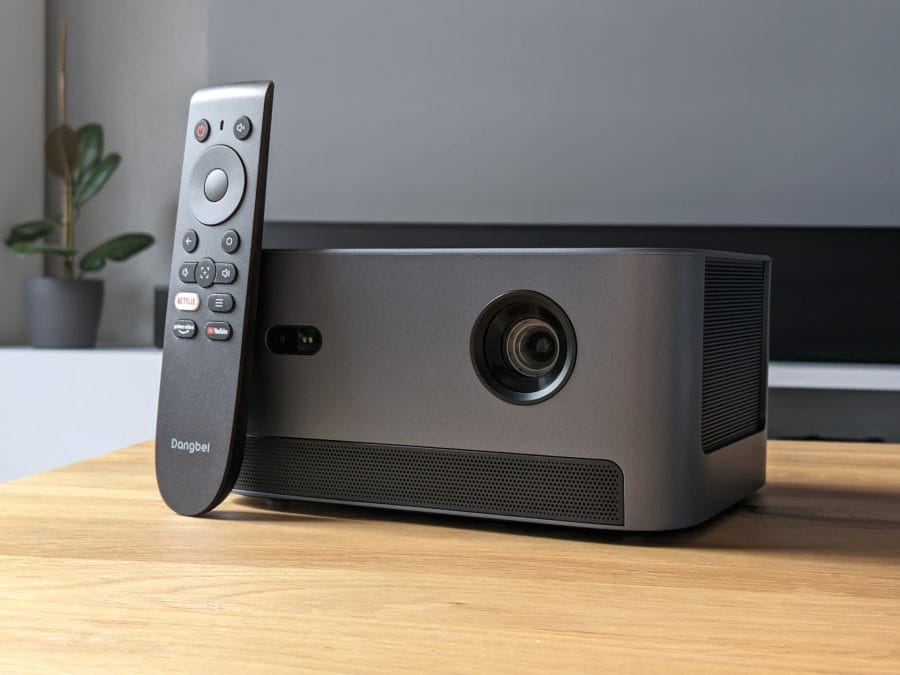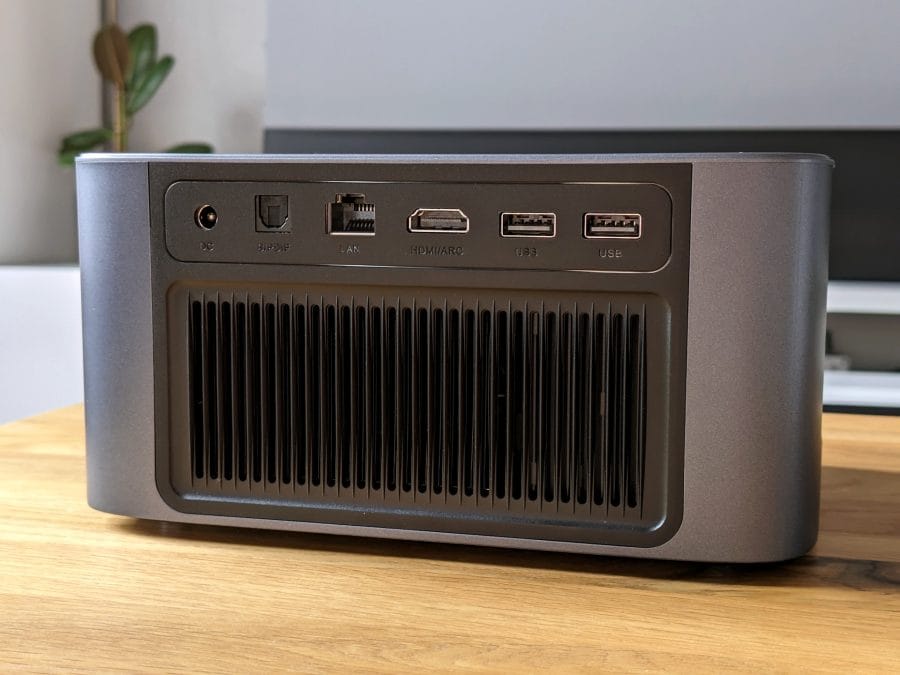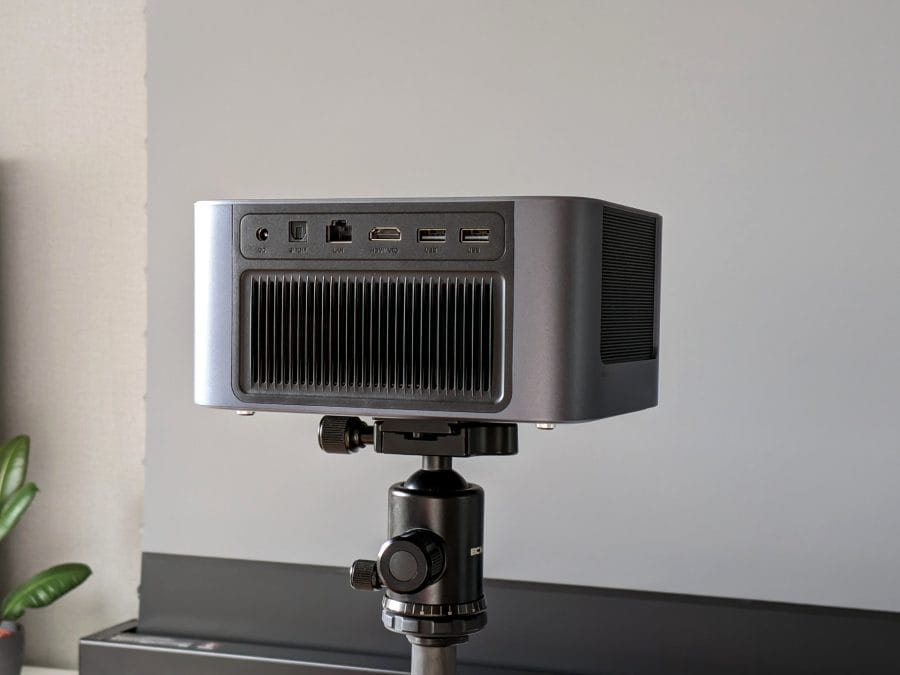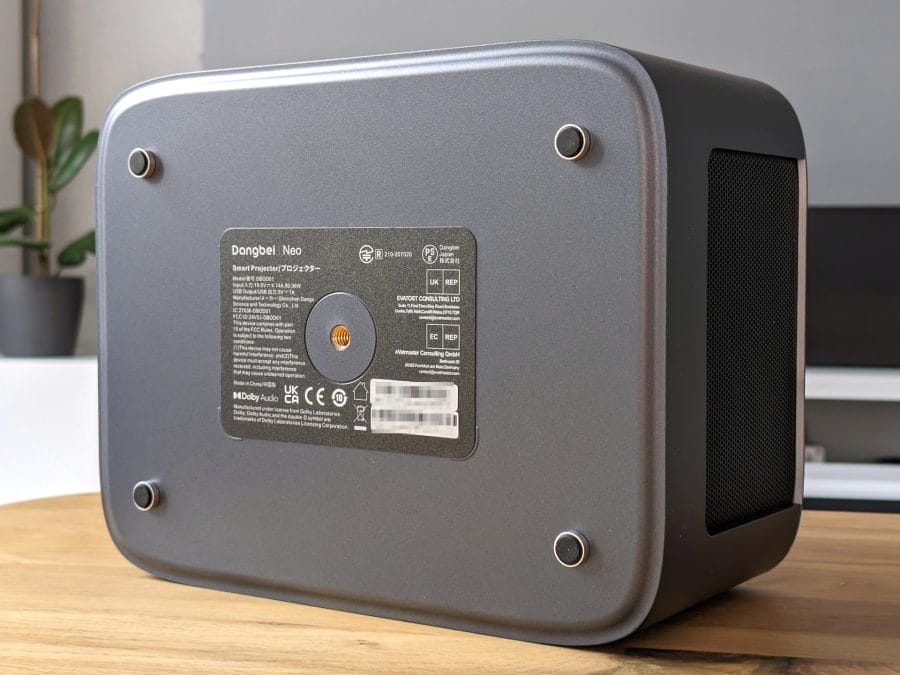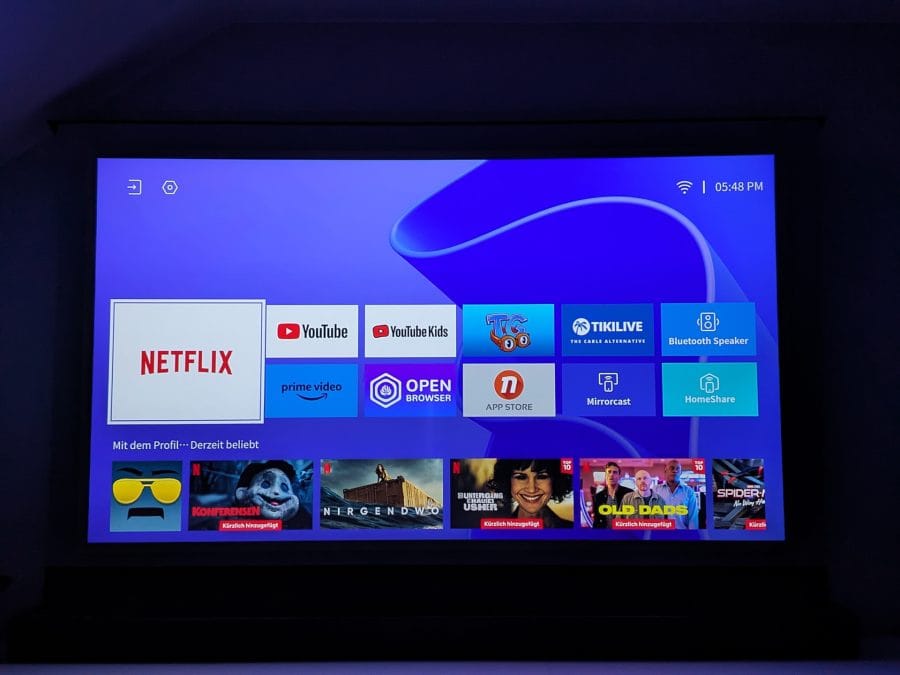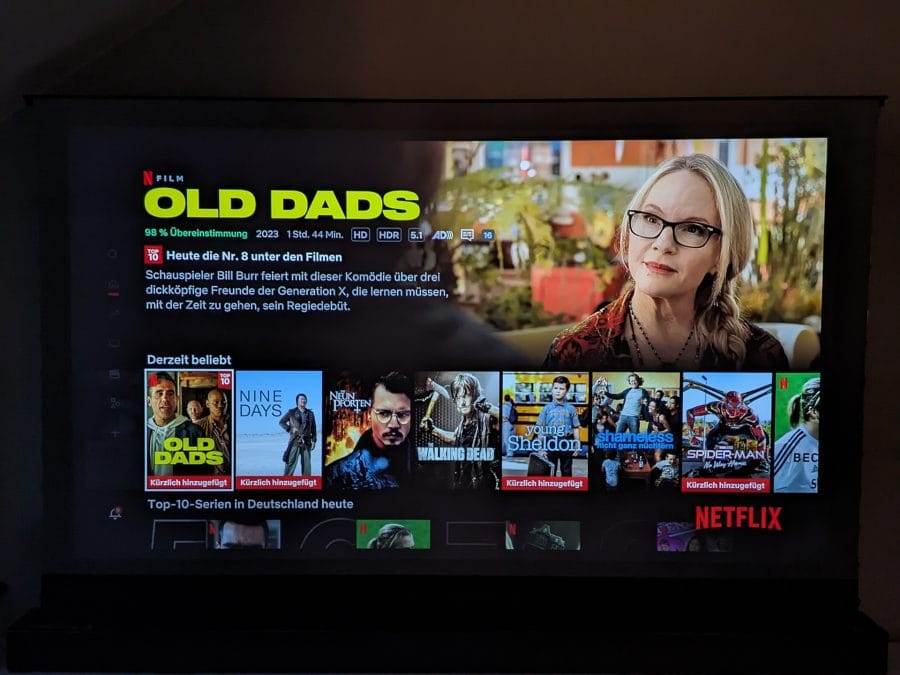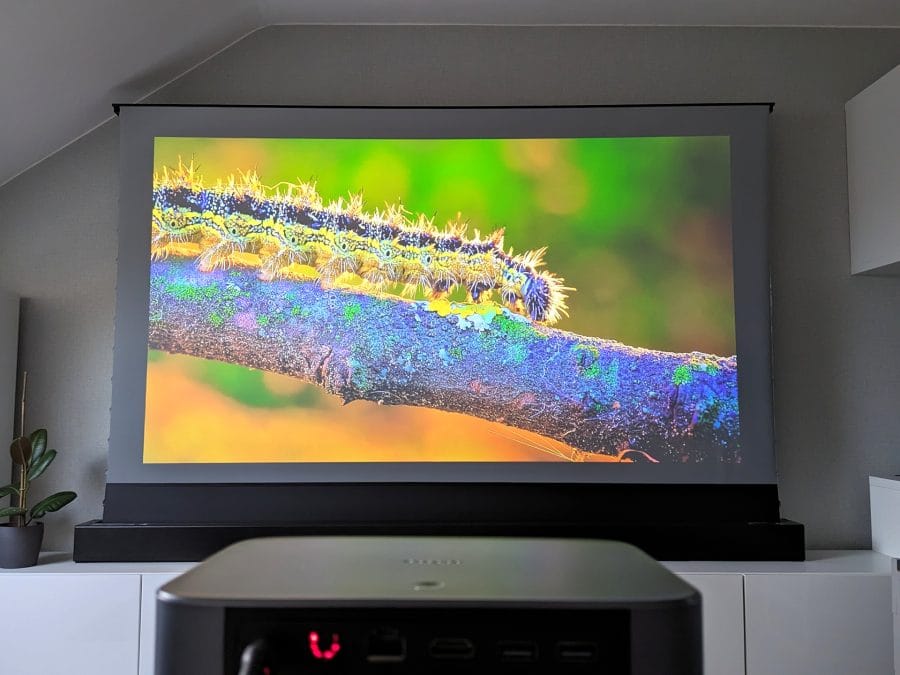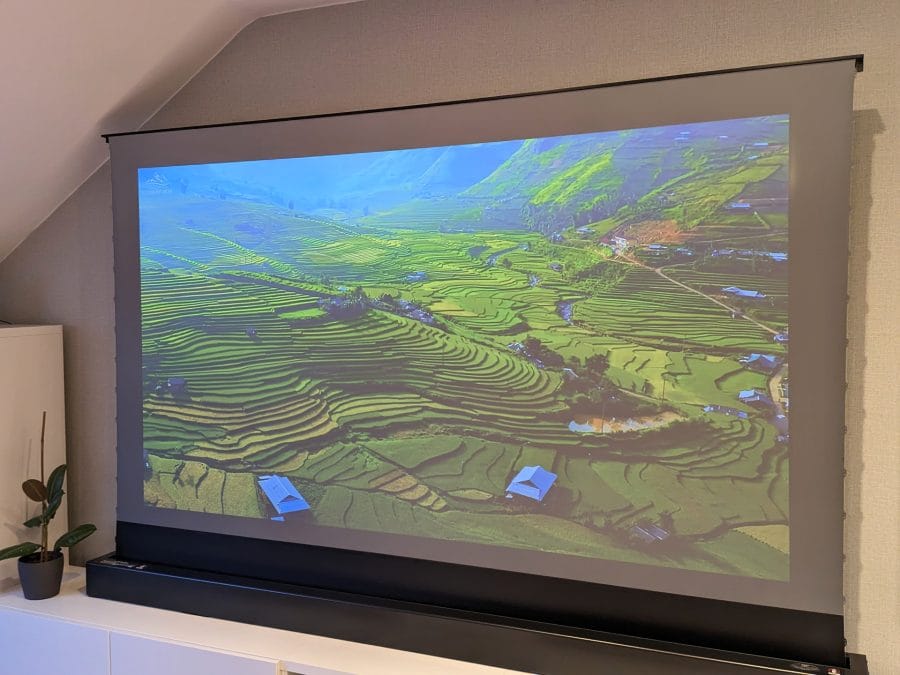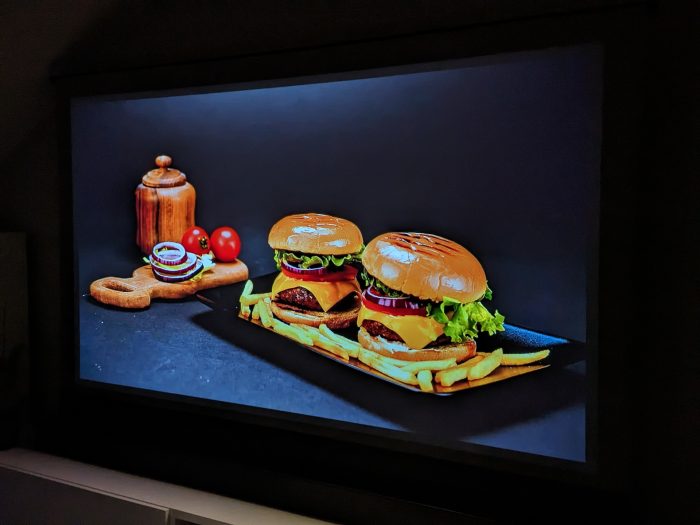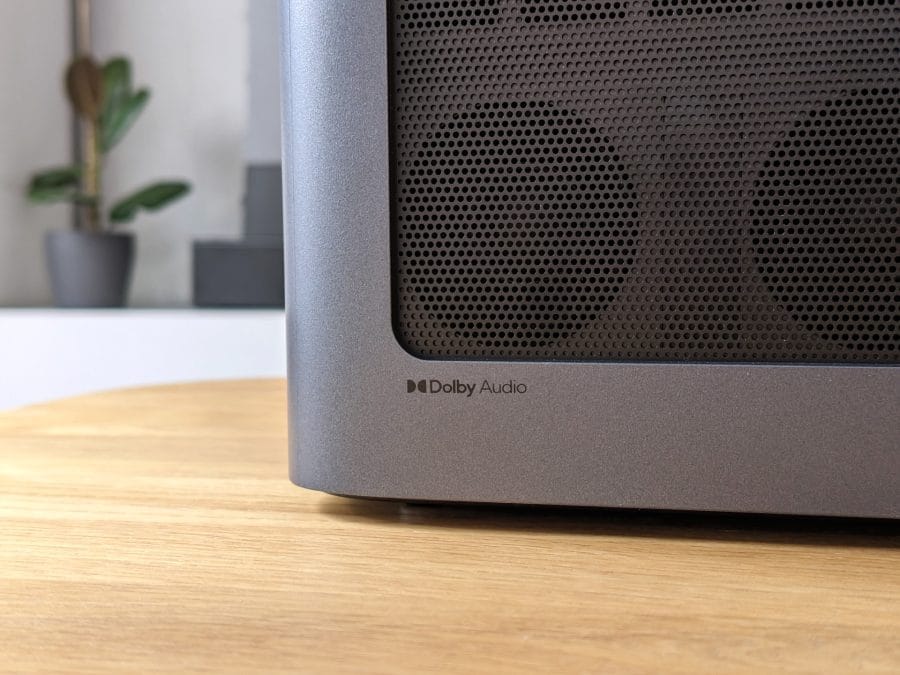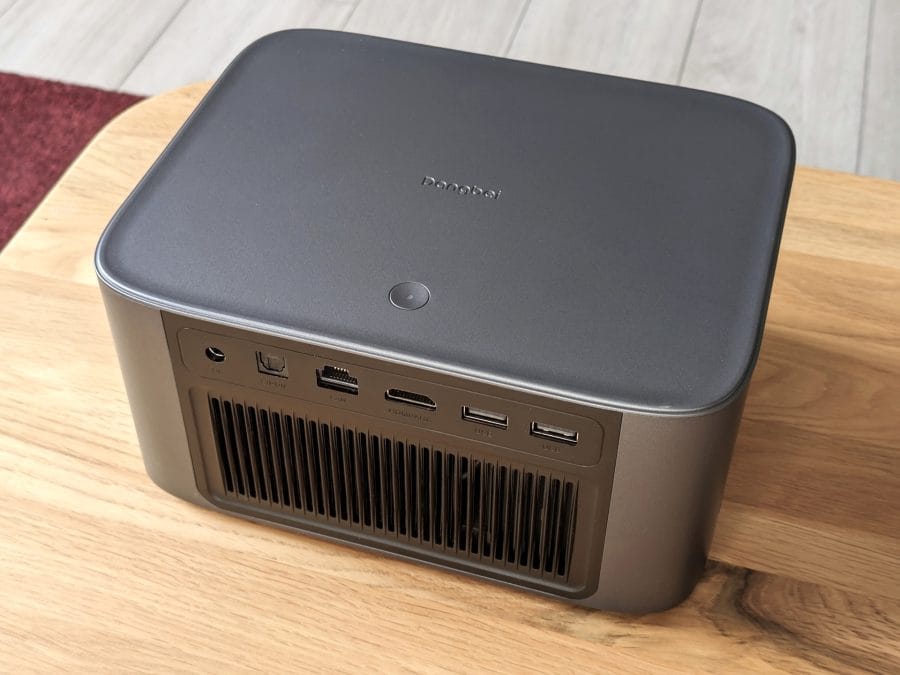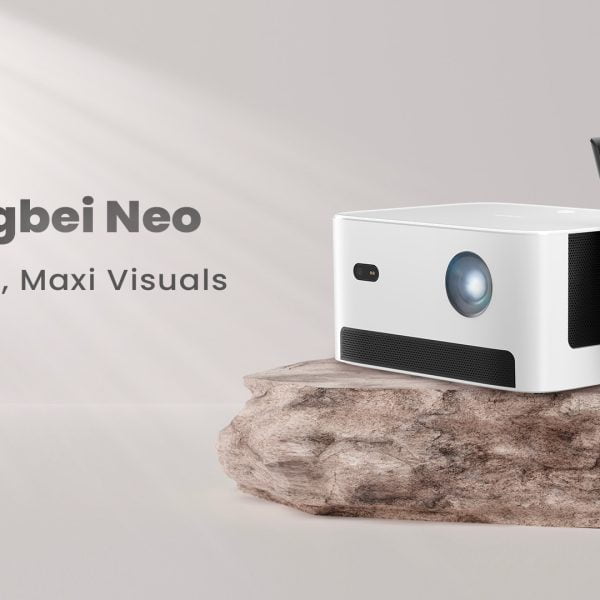Dangbei Neo: design, workmanship and scope of delivery
With dimensions of 20 x 15,7 x 10 cm, the Dangbei Neo falls into the mini projector segment. Although it is not one of the flattest models with a height of 10 cm, it remains easy to transport and flexible. The projector can be easily stored in a backpack and set up for various occasions as long as a power source is available. This mini projector does not have an integrated battery.
The housing is made of plastic and the color of the projector is available in white or blue, although in reality the blue looks more like anthracite. The lens is at the front, next to it is the ToF sensor for auto-focus and auto-keystone. There is no manual focus wheel or anything like that. The control buttons are also essentially limited to a single power button, while operation is carried out entirely via the included Bluetooth remote control.
The two 6 watt speakers are hidden behind decorative grilles on the sides. Dangbei has housed all connection options in the back: an HDMI 2.0 input, two USB 2.0 inputs, a LAN input for a wired network connection, an S/PDIF output and the DC power input. An additional HDMI input would certainly have been useful, but other manufacturers in the mini class also use it sparingly.
On the bottom of the Dangbei Neo there are four small feet at each corner that can be unscrewed for ceiling mounting or fine adjustment on uneven surfaces. There is also a 1/4" tripod thread in the center, which allows it to be attached to a tripod or other device.
The workmanship is solid and the scope of delivery includes everything you need: the projector itself, a remote control and the power supply.
Dangbei Neo: Hardware
The Dangbei Neo uses an LED light source combined with a 0,33-inch DMD chip, which offers a native resolution of 1368×768 pixels. By using XPR, a pixel shift technology from Texas Instruments, the mini projector is able to project images in full HD quality. Content in high-resolution 4K HDR10 or HLG can be displayed through downsampling.
The light intensity of the projector is specified as 540 ISO lumens and the lifespan of the light source is specified as more than 30.000 hours. A projection ratio of 1.2:1, combined with a fully motorized optical block, ensures automatic focusing. The technical equipment is complemented by intelligent functions such as the camera-supported keystone, obstacle detection and automatic image format recognition.
Dangbei does not provide any information about the hardware responsible for the Smart TV.
Dangbei Neo: Alignment and software
Orientation
Commissioning the Dangbei Neo is extremely user-friendly, as the projector carries out most of the alignment steps independently thanks to its intelligent features. The automatic focus sets the sharpness precisely and the automatic keystone only requires manual correction in rare cases, which is possible using four corner points in the range of +- 30°. Unfortunately, there is no more precise eight-point correction.
The automatic obstacle detection is cumbersome. The projector does not recognize a white light switch on a white wall. However, objects with a high contrast to the background, such as houseplants protruding into it, do. The projection ratio of 1.2:1 results in the following image sizes according to distance:
| distance (meters) | Projection size (inches) |
| 1,62m | 60" |
| 2,17m | 80" |
| 2,70m | 100" |
| 3,26m | 120" |
Software
The software setup process is well explained and can be completed in just a few minutes. First, the Bluetooth remote control is paired, then the language and region are set and, if necessary, the connection to the WLAN is established - and the device is ready for use.
You then land on the home screen, which clearly displays the 11 installed apps in the form of tiles. The apps include Netflix, YouTube and Prime Video. There is also an app store (Netrange), although the range of apps is significantly reduced compared to Android TV. Simply installing Disney Plus, Spotify or other streaming providers doesn't work, for example, which gives Android TV a clear advantage when it comes to apps.
The Dangbei Neo handles playing content on Netflix or Prime Video without any problems. It is also exciting that the account sharing block does not apply to Netflix because the Dangbei Neo is not identified by Netflix as a TV, but as a PC, and PCs have so far been spared from the block. As an alternative to streaming providers, content can also be streamed via MirrorCast, HomeShare or the network. The device also recognizes classic USB data carriers with media content.
If you go into the settings, the operating system reveals itself as "Tionndadh OTA", which suggests that it may be a variant of Ubuntu Touch. When it comes to image options, the Dangbei Neo takes a simple approach. Users can choose between five preset picture modes: Standard, Cinema, Sport, Vivid and an individually configurable user mode. Dangbei has omitted a game mode, which usually reduces the input lag in games.
In user mode, the basic parameters such as contrast, brightness (software side), color temperature and saturation can be adjusted. The setting options for grayscale or color management in the RGB area are completely missing, which would have been of particular interest to demanding users. The video processing is also rather rudimentary and does not reach the level of a home cinema projector. Things like dynamic contrast or MEMC, a technology that makes low frame rates play more smoothly, are missing.
Dangbei Neo: suitable for home cinema
picture quality
When it comes to image quality, the Dangbei Neo cuts a good figure. The brightness is enough to project a 90" large, attractive image onto the screen even in dim light. However, the specified brightness of 540 ANSI lumens is not sufficient for use in daylight, unless you are willing to settle for a significantly reduced level Image size satisfied.
In a darkened room, the Dangbei Neo shows what he's made of. The projected image impresses with its sharp image and even illumination right into the corners.
The colors lack a bit of warmth, which is why the display slips into a bluish tone. Although you can help with the color temperature setting and the gamma, the lack of color settings also changes the color accuracy. However, this is criticism at a high level, because you should not forget that this is a portable mini projector and not a stationary home cinema projector. For the target group and the intended applications, the Dangbei Neo does its job very well.
- Darkened room
The Dangbei Neo reveals a weakness in the contrast ratio, which is not unusual in this device segment. The black level lacks depth and instead tends to fade into a dark gray. This is particularly noticeable in dark film scenes or at the edges of the image, especially when the image is indented through object avoidance or keystone correction.
Audio and operating volume
The two 6W speakers deliver a pleasant sound that is, in a positive sense, far removed from what we know from business projectors, for example. They are quite suitable for a spontaneous movie night or a gaming session, so external speakers are not absolutely necessary.
The sound tuning tends towards a neutral reproduction with a slight presence in the midrange, which improves the intelligibility of dialogue. However, deep bass is not to be expected. The small speakers simply lack the volume for this.
The active fan can be clearly heard during operation. The Dangbei Neo is not one of the loudest projectors, but it is also far from being classified as quiet. At a distance of half a meter, the operating noise is around 37 dB, which is roughly the same as a laptop with a fan running at full speed. The background noise can be annoying in the long run, but on the other hand you quickly get used to it.
Gaming
Mini projectors are often not the first choice for gamers due to their higher input lag, the time delay between the input signal and the image output. Dangbei specifies the Neo with a low latency of 30 ms - a value that seems acceptable in principle for gaming. However, reality shows, with a measured latency of 85 ms, that the value is significantly higher.
For games that require quick reactions, the Neo is definitely not the best option. However, for less demanding games, such as a round of Mario Party with friends, the higher latency is less significant.

Dangbei Neo
Chic design and good workmanship
Easy commissioning and alignment
Ethernet connection
Supports Netflix
Long lamp life
Good image quality in the dark
Good speaker system
No control panel on the device
Limited app offering
Weaknesses in obstacle detection
No color management
Audible fan noise
High input lag for gaming
The Dangbei Neo presents itself as an attractive option for anyone looking for a compact and easy-to-use device. Its operating system, which is presumably based on Ubuntu Touch, is characterized by a clear and concise user interface and represents a welcome change in this device class. The support for Netflix in particular sets it apart from other devices that often have to struggle with licensing problems. However, compared to projectors with Android TV, the app selection is significantly more limited, which makes the user-friendliness somewhat less enjoyable.
In terms of image quality, the Neo can certainly impress in the right environment. It delivers solid performance with good brightness and sharpness under dim lighting conditions. Daylight, on the other hand, is hard on it and the color reproduction could be warmer overall, although you can still adjust the settings here. Contrast and black levels are sufficient for normal home cinema, but reach their limits with higher demands.
When it comes to volume, you have to make compromises with the Neo. The fan is clearly audible and can affect the movie experience in quiet scenes. What is worth mentioning, however, is the good performance of the built-in 6W speakers, which deliver adequate sound for this device class.
In summary, the Dangbei Neo is particularly interesting for those who are looking for an uncomplicated, mobile mini projector that particularly shines when using streaming services such as Netflix. However, if you're looking for a fully-rounded home theater experience or a machine for responsive gaming, you should adjust your expectations accordingly or consider alternatives.

